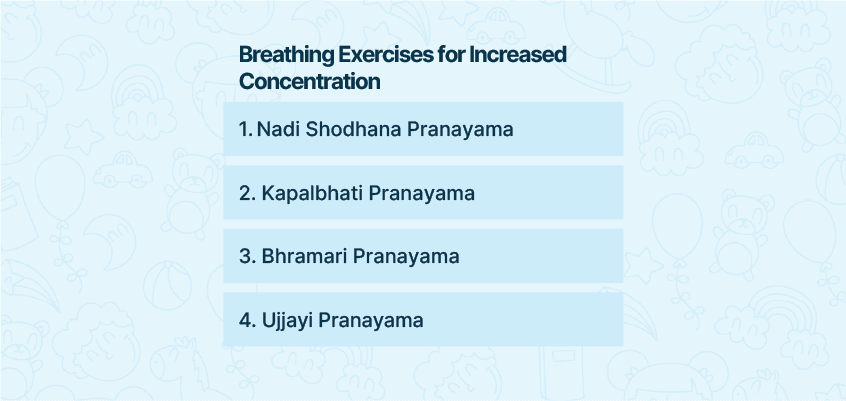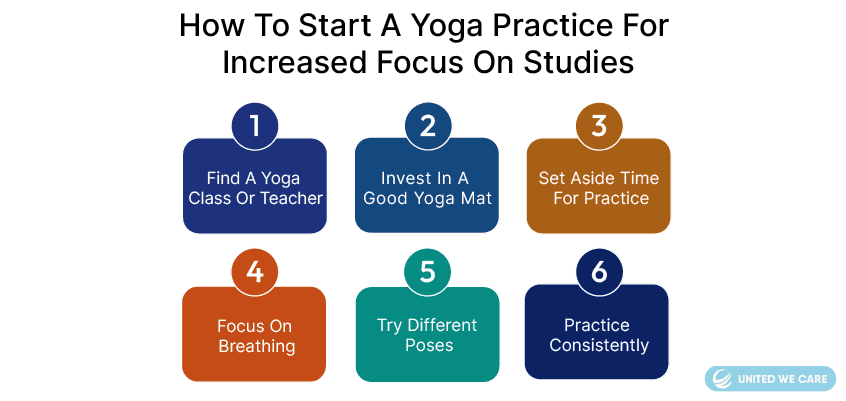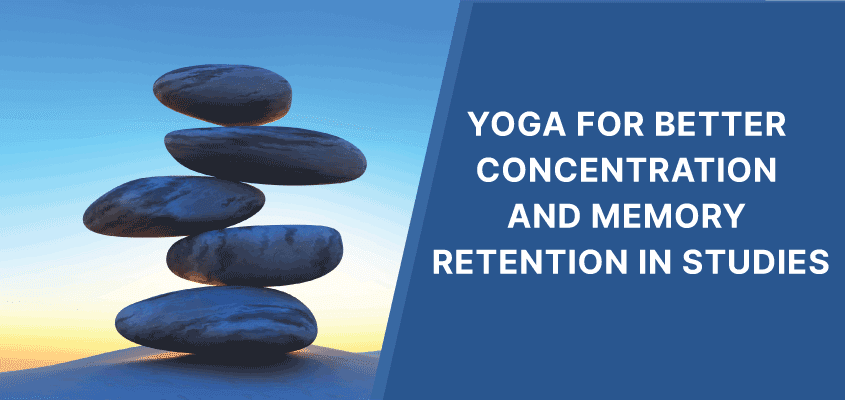Introduction
Are you a student finding it difficult to concentrate on your studies and remember information? We all go through a stage in life where we have so much to do that our mind just stops working, isn’t it? When I was a student, I’ve has this issue a lot of times. What helped me the most was practicing yoga. If you are wondering what “Yoga” is, it means ‘union’- the combination of body movement, breath control, and meditation. It helps you to take care of your overall health and well-bring. In this article, let me help you understand how yoga can help you with your studies and what kind of yoga postures and breathwork are the best for concentration and memory.
“Yoga means union of heart, mind, body, and spirit. It unites us and the people around us.” -Sri Sri Ravi Shankar [1]
How Yoga Helps In Increasing Concentration in Studies
People all over the globe have started practicing yoga. Since there is no age bar, you can do it at any stage of your life. Here’s how yoga can help you with your concentration levels [2]:
- Mind-Body Connection: When you start yoga, you will be able to realize that your body and your mind have started getting aligned with each other. You can do that by breathing while you change your yoga poses. That way, you can become more aware of your thoughts and your body and remain in the present. Doing so can help you even with your studies over a period of time.
- Stress Reduction: Yoga is an extremely effective way to reduce stress. While studying, if you are stressed, you will not be able to focus and remember anything. Yoga can help you feel relaxed and calmer. The more calm and relaxed you are, the better you can concentrate.
- Improvement in Blood Flow and Oxygen Levels: The ultimate aim of yoga and breathwork is to improve blood flow and oxygen levels throughout the body. Even for your studies, when the blood starts flowing in a better manner to the brain, your focus and memory centers in the brain will get activated, helping you in a better manner.
- Be in the Present: You can learn to be in the present moment through mindfulness and meditation practices as a part of yoga. Being mindful and in the present moment, you can decrease distractions and increase focus while studying.
- Commitment and Discipline: Practicing yoga regularly will help you become more disciplined and committed. This discipline and commitment will help you form a better routine and schedule for your studies. That way, you can maintain focus for a longer period of time.
Read more about– Top 10 benefits of meditation
Enhance Concentration And Memory Retention With These Ten Yoga Poses
These asanas can help to improve your memory, concentration, and your overall health: [3]

- Bakasana (Crane Pose): This pose helps you to improve your balance issues. When you are able to maintain a balance in your body, you will know what it takes to concentrate on something. So, your focus and concentration on your studies will also increase.
- Padmasana (Lotus Pose): This pose helps you get rid of the stiffness around your neck and your shoulders. That way, you can feel more relaxed. A relaxed mind is able to focus on learning in a better manner.
- Padahastasana (Standing Forward Bend): Did you know all the nerves in our body are connected to our brain? Doing this asana can help you to energize your nervous system. Because your entire body is feeling energetic, your brain will be able to receive blood flow. When there is good blood flow to the brain, your concentration and memory will increase.
- Sarvangasana (Shoulder Stand Pose): This asana also helps to increase blood circulation in your body and with your digestion. When there is better blood flow, you’ll feel less tired and not get headaches. In fact, it can even help you overcome sleep issues and hypertension. All in all, this pose is great for relaxing yourself and your mind and increasing focus.
- Halasana (Plow Pose): This pose is an amazing way to get rid of all kinds of stress from your body and your mind. In fact, you’ll realize the more you do this pose in a proper manner, the less tired you’ll feel. A fresh body and mind are ready to concentrate more and remember information better.
- Paschimottanasana (Seated Forward Bend): This pose is amazing for curing headaches. So, obviously, if you don’t have a heavy feeling in your head, you’ll be able to think better, focus better, and remember things better, won’t you?
- Vrikshasana (Tree Stand Pose): Oh, I could stand for a long time in this pose. That’s how much it relaxes and calms you down. It helps you stretch your entire body, sending an energetic vibration throughout. These energy levels can help you gain more balance and focus in your life.
- Sukhasana (Easy Pose): In this pose, you just have to sit idle with your legs crossed. It is the best pose to relax yourself completely. In fact, this pose really helps you to bring your focus to each and every part of your body. Meditating in this pose can help your focus, concentration, and memory levels to become excellent.
- Vajrasana (Diamond Pose): This pose is great for digestion. If your stomach is happy, so will your mind. In fact, this pose also helps in blood circulation and increases your mental balance. Sitting in this pose for 10-15 minutes a day can help you increase your focus levels in a better manner.
- Supta Virasana (Reclining Hero Pose): I would like this single pose to be a master pose. From top to bottom, you can manage everything by practicing this pose regularly, from sleep issues to thyroid to depression to stomach issues, everything. You can even improve your muscle strength. So, if this is sort of a master pose, won’t you be able to improve your concentration? Of course, you will.
Must read– How to use guided meditation to reduce depression and anxiety
Breathing Exercises For Increased Concentration
Prana is the life force as per the yogic tradition. It’s the crucial energy controlling everything in the universe. Without prana, the body cannot live. [4]
Pranayama helps in controlling this energy by controlling the breath. It includes a lot of breathwork to draw in this cosmic energy.
In fact, there are some specific pranayamas that you can practice in order to increase your concentration and memory:

- Nadi Shodhana Pranayama (Alternate Nostril Breathing): While practicing the nadi shodhana pranayama, you will have to breathe in through one nostril, close that, and breathe out through the other. This pranayama is also called Anulom Vilom Pranayama. Doing this pranayama in the long term will help you keep calm and improve your focus levels.
- Kapalbhati Pranayama (Skull Shining Breathing): When you do kapalbhati pranayama, you have to forcefully exhale from the nose, in such a way that it seems like your stomach is hitting the spine. The inhalation during this pranayama is mostly passive. Your body will know when it wants to inhale. It is a great breathing exercise that can help to increase the blood flow and oxygen level in the body. That way, you can have a clear head and better mental health.
- Bhramari Pranayama (Bee Breath): Bhramari Pranayama is an excellent breathing technique to reduce stress and have a calm mind. In this pranayama, you have to place your hands on your eyes and, with your thumbs, close your ears. Take a deep breath in, and while exhaling, make a humming sound like a bee. It absolutely relaxes your entire body and mind.
- Ujjayi Pranayama (Victorious Breath): One sure technique to help you with concentration is ujjayi pranayama. In this pranayama, you have to breathe in and out through the nose while restricting the back of the throat. It really helps in increasing oxygen in the brain.
Read more about– Seven simple ways to improve your concentration and study
How To Start A Yoga Practice For Increased Concentration On Studies
If you want to start practicing yoga, it can be very easy. Here’s what you need to do [5]:

- Find a Yoga Class or Teacher: You can begin by finding a yoga class or teacher in your area. In fact, post the pandemic, there are a lot of online classes being conducted. So, search for a teacher who understands your needs and probably has a specialization in focus and concentration in studies.
- Invest in a Good Yoga Mat: Having a yoga mat is the basic requirement for yoga. So, get yourself a good-quality mat that does not slip. That way, you can be comfortable while practicing, and it can actually be fun.
- Set Aside Time for Practice: Yoga requires discipline. So, you can start by keeping aside 20-30 minutes every day, probably including pranayama. Slowly, you can start increasing your time as you get used to and comfortable with the process.
- Focus on Breathing: Remember that when you start practicing yoga, you also need to pay attention to how you are breathing. Apart from that, you can set aside a few minutes just to do breathwork (pranayama). Start with a few minutes, and you can find yourself becoming calm and focused.
- Try Different Poses: One of the best things you can do is experiment with different yoga poses. Since there is no ‘one-size-fits-all’ policy, you don’t know which one works best for you to build focus and make your mind active.
- Practice Consistently: Lastly, make yoga a habit when you practice it regularly. Bringing yoga into your daily life is absolutely necessary to improve your concentration and memory retention in your studies.
Conclusion
Yoga is now globally becoming a synonym for calmness and relaxation. So, if you are looking to practice yoga for improving your concentration and memory, you are on the right path. Yoga includes a number of poses and breathing techniques (pranayamas) that can really help you, not just for mental health but also for physical and emotional health. Just experiment with the poses and see what works best for you. Yoga is personal, so learn to listen to your body and build your practice slowly and at your own pace.
If you are looking to start your yoga practice for concentration and memory, reach out to our mental health experts at United We Care! At United We Care, a team of wellness professionals and mental health experts will guide you with the best methods for well-being.
References
[1] “Top 20 Quotes on Yoga by Gurudev,” Art Of Living (India), Aug. 08, 2022. https://www.artofliving.org/in-en/yoga/yoga-beginners/top-yoga-quotes
[2] “Yoga Postures, Exercises, and Asanas to Help Improve Concentration: Yoga for Students,” Exambazaar, https://www.exambazaar.com/blogpost/yoga-for-students
[3] “Top 10 Yoga Poses To Improve Your Memory,” STYLECRAZE, Nov. 27, 2013. https://www.stylecraze.com/articles/yoga-poses-to-improve-your-memory/
[4] A. Metivier, “Yoga for Concentration and Memory: Everything You Need to Know,” Magnetic Memory Method – How to Memorize With A Memory Palace, Sep. 28, 2020. https://www.magneticmemorymethod.com/yoga-for-concentration-and-memory/
[5] E. Ekhart, “8 tips on how to do yoga at home – Practice and all is coming,” Ekhart Yoga, Nov. 02, 2017. https://www.ekhartyoga.com/articles/practice/8-tips-on-how-to-do-yoga-at-home-practice-and-all-is-coming










